“‘Something Better’: The Female Relief Society of Nauvoo,” Daughters in My Kingdom: The History and Work of Relief Society (2011), 9–26
“Chapter 2,” Daughters in My Kingdom, 9–26
Chapter 2
“Something Better”
The Female Relief Society of Nauvoo
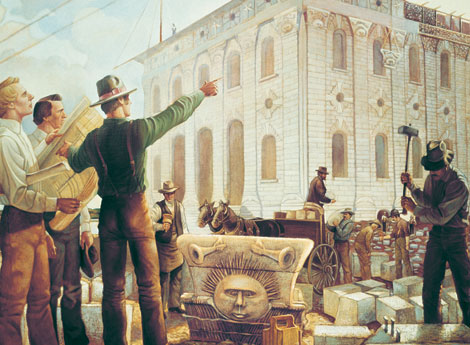
The Saints felt an urgency to build the Nauvoo Temple.
Joseph Smith at the Nauvoo Temple, by Gary Smith. © Gary Smith.
In the spring of 1842, the Latter-day Saints in Nauvoo, Illinois, worked enthusiastically to build a temple in their city. The Prophet Joseph Smith encouraged everyone to help. Men did the actual construction of the temple, and women eagerly sought ways to contribute as well. Sarah M. Kimball recounted:
“The Nauvoo Temple walls were about three feet high. Strong appeals were being made by the President of the Church and others for help to forward the work.
“Miss [Margaret] Cook … one day in conversation with me on the subject of a recent appeal for provisions, clothing, bedding and general supplies for the workmen and their families, remarked that she would be pleased to contribute needlework if it could be made available. I proffered material for her to make up, and suggested that others might feel as we did. We then [discussed] the subject of organizing a sewing society. The object of which should be to aid in the erection of the temple.
“About a dozen of the neighboring sisters by invitation met in my [home] the following Thursday.”1
In that era, it was a popular practice for women to form their own organizations, often with constitutions and bylaws—sets of rules to govern the organizations. The women who met at Sarah Kimball’s home decided to establish a constitution and bylaws, and Eliza R. Snow accepted the responsibility to write them. Then the women asked Joseph Smith to review them and give his opinion of them. After the Prophet read them, he said they were “the best he had ever seen. ‘But,’ he said, ‘this is not what you want. Tell the sisters their offering is accepted of the Lord, and he has something better for them than a written constitution. I invite them all to meet with me and a few of the brethren … next Thursday afternoon, and I will organize the women under the priesthood after the pattern of the priesthood.’”2
Organizing the Relief Society
“The Relief Society was established by the spirit of inspiration, and has been guided by that spirit [ever since], and has instilled into the hearts of countless of our good sisters those desires for righteousness which have been pleasing to the Lord.”
Joseph Fielding Smith
Relief Society Magazine, Dec. 1970, 883
That next Thursday, on March 17, 1842, twenty women assembled on the upper floor of a building, often called “the red brick store,” where Joseph Smith had an office and a business to support his family. They met under the direction of Joseph Smith and two members of the Quorum of the Twelve Apostles, Elders John Taylor and Willard Richards.3
Rather than pattern a Latter-day Saint women’s organization after the women’s societies that were prevalent and popular at that time, the Prophet Joseph Smith organized them in a divinely inspired and authorized manner.
Early in the meeting, he told the sisters that they were to encourage “the brethren to good works in looking to the wants of the poor—searching after objects of charity, and in administering to their wants—to assist by correcting the morals and strengthening the virtues of the female community.”4
Joseph Smith’s wife Emma was chosen to serve as the president of this new society. The Prophet then encouraged his wife to choose counselors who, with her, would “preside over this society, in taking care of the poor—administering to their wants, and attending to the various affairs of this institution.” Sister Smith chose Sarah M. Cleveland and Elizabeth Ann Whitney as her counselors. Elder Taylor later set apart each counselor by the laying on of hands to act in her office in the presidency.5
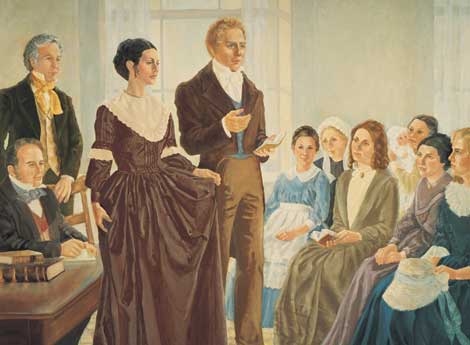
On March 17, 1842, Emma Smith became the first president of the Relief Society.
Organization of the Relief Society, by Nadine B. Barton. © 1985 IRI.
As the meeting continued, Joseph Smith said that his wife’s calling fulfilled a prophecy revealed to him about 12 years earlier, in which the Lord spoke to her as “an elect lady, whom I have called” and told her that she would be “ordained under [Joseph Smith’s] hand to expound scriptures, and to exhort the church, according as it shall be given thee by my Spirit.”6 Joseph Smith read that entire revelation, which is now section 25 of the Doctrine and Covenants, to those in attendance.7
In the revelation, the Lord told Emma of privileges that were to be hers, such as being a scribe for her husband and compiling hymns for the Saints. The Lord also counseled Emma to heed warnings, to be faithful and virtuous, to not murmur, to comfort her husband and be of help to him, to teach from the scriptures and exhort the Church, to write and learn, to “lay aside the things of this world, and seek for the things of a better,” to keep covenants, to be meek and beware of pride, and to keep the commandments.8
At the conclusion of the revelation, the Lord declared that what He had said to Emma was not for her alone but was His “voice unto all.”9 With prophetic authority, Joseph Smith reiterated this point, emphasizing that the counsel and warnings in this revelation applied to all members of the newly organized society. He said “that not [Emma] alone, but others, may attain to the same blessings.”10 This revelation established foundational principles for Latter-day Saint women.
After some discussion, the sisters decided to call themselves the Female Relief Society of Nauvoo. Emma Smith declared: “We are going to do something extraordinary. … We expect extraordinary occasions and pressing calls.”11
John Taylor Portrait. Courtesy Church History Library.
John Taylor
At the end of the meeting, Elder John Taylor shared his thoughts. He said that his “heart rejoice[d]” when he saw “the most distinguished characters stepping forth in such a cause, which is calculated to bring into exercise every virtue and give scope to the benevolent feelings of the female heart.” He also rejoiced “to see this institution organized according to the law of heaven—according to a revelation previously given to Mrs. [Emma] Smith appointing her to this important calling—and to see all things moving forward in such a glorious manner.” His prayer was that “the blessings of God and the peace of heaven may rest on this institution henceforth.” A choir then echoed Elder Taylor’s remarks, singing “Come let us rejoice in the day of salvation” before the closing prayer.12
Priesthood Authority, Patterns, and Blessings
In a Relief Society meeting six weeks later, the Prophet Joseph Smith taught the sisters at length and then said: “This society is to get instruction through the order which God has established—through the medium of those appointed to lead—and I now turn the key to you in the name of God, and this society shall rejoice and knowledge and intelligence shall flow down from this time—this is the beginning of better days to this society.”13
As the Lord’s prophet, Joseph Smith held all the keys of priesthood authority on the earth. Therefore, when he organized the Relief Society to function under his overall direction, he unlocked opportunities for the women of the Church to play vital roles in the work of the Lord’s kingdom. They now served under the authority of the priesthood and were promised blessings beyond those they had already received. These blessings would come to them according to their faithfulness and diligence. Knowledge and intelligence would flow to them as they received a fulness of priesthood blessings in the temple. They would receive ordinances and make sacred covenants that would help them prepare themselves and their families for eternal life. (For more on the Relief Society and the priesthood, see chapter 8.)
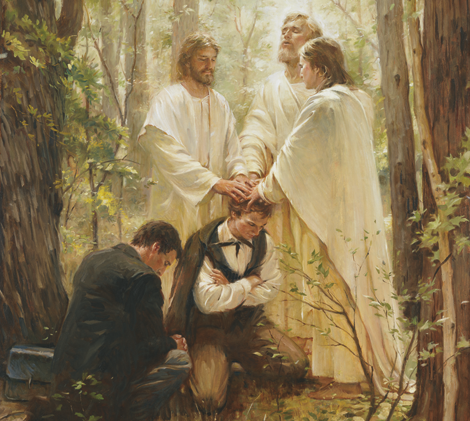
Through Peter, James, and John, the Lord bestowed “the keys of [His] kingdom” on Joseph Smith (see D&C 27:13).
Restoration of the Melchizedek Priesthood, by Walter Rane. © IRI.
Early Excitement about Relief Society
The Female Relief Society of Nauvoo grew rapidly, reaching a membership of more than 1,100 in August 1842. Initially, membership in the society was not automatic for all female members of the Church. Women had to petition to belong, and they were accepted based on their goodness and virtue. Joseph Smith said, “There should be a select society, separate from all the evils of the world, choice, virtuous, and holy.”14
Sisters in Nauvoo clamored to join the Relief Society. They were excited to give temporal and spiritual aid in an organized, authorized way. They also recognized the unparalleled opportunity to be taught by a prophet in preparation for higher spiritual knowledge and the blessings of the temple. They loved being unified with one another and with their priesthood brethren in these great causes.
Now that the sisters had this privilege, they had a responsibility to live up to it. Joseph Smith told them: “You are now placed in a situation where you can act according to those sympathies which God has planted in your bosoms. If you live up to these principles, how great and glorious!”15 As President Boyd K. Packer of the Quorum of the Twelve Apostles said many years later, “It is as obligatory upon a woman to draw into her life the virtues that are fostered by the Relief Society as it is an obligation for the men to build into their lives the patterns of character fostered by the priesthood.”16
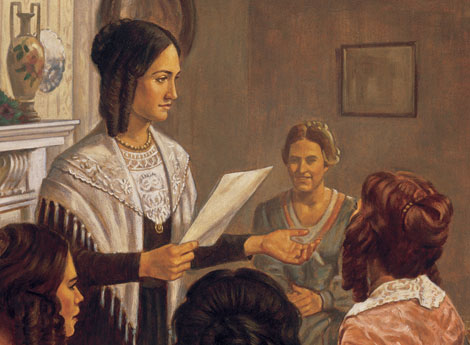
Emma Smith conducted Relief Society meetings.
Emma Smith, by Robert Barrett. © 1991 Robert Barrett.
The Relief Society was not just another group of women trying to do good in the world. It was different. It was “something better” because it was organized under priesthood authority. Its organization was a necessary step in the unfolding of God’s work on the earth. It prepared the women of the Church to receive priesthood ordinances and covenants, and it helped them with their family responsibilities.
Joseph Smith’s Instructions
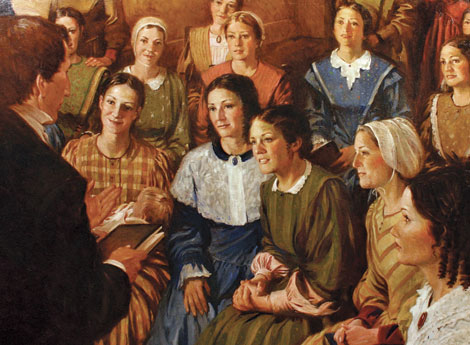
The Prophet Joseph Smith instructed Relief Society sisters.
Detail from Come Let Us Rejoice, by Walter Rane. Courtesy Church History Museum.
In the first meeting of the Female Relief Society of Nauvoo, Sister Eliza R. Snow was appointed to be the secretary of the organization. In that capacity, she took careful and detailed notes, which were called minutes, at each Relief Society meeting she attended. Joseph Smith told the sisters that these minutes would become the “constitution and law” of the society.17
In most Relief Society meetings, the sisters devoted time to receiving instruction. The sisters were blessed to be taught by the Prophet Joseph Smith in six of their meetings. As he taught, they felt rich outpourings of the Spirit. At the end of one of these meetings, Sister Snow recorded, “The Spirit of the Lord was poured out in a very powerful manner, never to be forgotten by those present on that interesting occasion.”18
Of all the minutes Sister Snow recorded, her notes of the Prophet’s discourses were the most influential. The Prophet’s teachings in this setting guided the work of the Relief Society sisters and the priesthood leaders who served with them. Those teachings continue to influence the work of the Church today.
Joseph Smith taught principles that helped Relief Society sisters “relieve the poor” and “save souls”—foundational principles upon which the society was built.19 Established on this foundation, Relief Society has endured and increased in its influence. Since the early meetings of Relief Society, sisters have applied the Prophet’s teachings in their efforts to increase faith and personal righteousness, strengthen families and homes, and seek out and help those in need.
Increase Faith and Personal Righteousness
“The future of the [Relief] Society is full of promise. As the Church grows, its field of usefulness will be correspondingly enlarged, and it will be even more potent for good than it has been in the past. If all the sisters will rally to the support of the society, it will accomplish a mighty work and be a continued blessing unto the Church.”
Lorenzo Snow
Deseret Evening News, July 9, 1901, 1
Joseph Smith taught sisters that they had a solemn obligation to seek their own salvation. He said, “We can only live by worshipping our God—all must do it for themselves—none can do it for another.”20 He taught them to be righteous individuals, to become a holy people, and to prepare for temple ordinances and covenants. He encouraged them to be at peace with the Lord, with those around them, and with themselves: “Sisters … , shall there be strife among you? I will not have it—you must repent and get the love of God.”21 “Not war, not jangle, not contradiction, but meekness, love, purity, these are the things that should magnify us.”22
In one Relief Society meeting, the Prophet Joseph discussed chapter 12 of the book of 1 Corinthians, emphasizing that each sister, fulfilling her own role, was important to the entire Church. He gave “instructions respecting the different offices [in the Church], and the necessity of every individual acting in the sphere allotted him or her; and filling the several offices to which they were appointed.” He also warned against the disposition to “consider the lower offices in the Church dishonorable and to look with jealous eyes upon the standing of others.” This, he said, “was the nonsense of the human heart, for a person to be aspiring to other stations than appointed of God.”23 Through such teachings, he helped the sisters walk “in holiness before the Lord.”24
“If we would come before God,” Joseph Smith told the Relief Society sisters, “let us be pure ourselves.”25
Strengthen Families and Homes
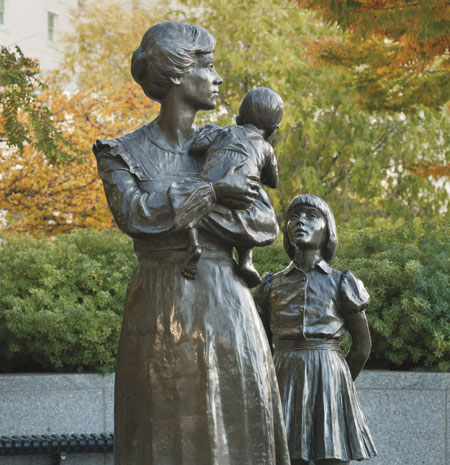
“Bring up your children in light and truth” (D&C 93:40).
Statue titled In Her Mother’s Footsteps by Dennis Smith.
Although the early Relief Society sisters were involved in their community and ready to serve their neighbors, they never lost sight of their responsibilities toward their own families and homes. They were true to their innate gifts as mothers and nurturers. They were also true to revelations the Lord had given through Joseph Smith about family responsibilities:
“The office of thy calling shall be for a comfort unto … thy husband, in his afflictions, with consoling words, in the spirit of meekness.”26
“Inasmuch as parents have children in Zion, or in any of her stakes which are organized, that teach them not to understand the doctrine of repentance, faith in Christ the Son of the living God, and of baptism and the gift of the Holy Ghost by the laying on of the hands, when eight years old, the sin be upon the heads of the parents.
“For this shall be a law unto the inhabitants of Zion, or in any of her stakes which are organized.
“And their children shall be baptized for the remission of their sins when eight years old, and receive the laying on of the hands.
“And they shall also teach their children to pray, and to walk uprightly before the Lord.”27
“I have commanded you to bring up your children in light and truth. …
“… First set in order thy house. …
“What I say unto one I say unto all. …
“… See that [family members] are more diligent and concerned at home, and pray always.”28
Excerpts from the minutes of the Female Relief Society of Nauvoo indicate that Joseph Smith and the sisters never lost sight of the principles in these revelations. Their words and actions showed that their homes and the homes of others were uppermost in their minds. For example, Emma Smith taught that “it was high time for mothers to watch over their daughters and exhort them to keep the path of virtue.”29 The Prophet Joseph expressed special concern about the relationship between husband and wife. He counseled the sisters: “Let this society teach how to act towards husbands, to treat them with mildness and affection. When a man is borne down with trouble—when he is perplexed, if he can meet a smile, not an argument—if he can meet with mildness, it will calm down his soul and soothe his feelings. When the mind is going to despair, it needs a solace. … When you go home never give a cross word, but let kindness, charity and love, crown your works.”30 In other settings, the Prophet gave similar counsel to men, saying that a husband’s duty is to “love, cherish, and nourish his wife” and “regard her feelings with tenderness.”31
When Relief Society sisters discussed ways to help people in their community, they often focused on families and homes. The minutes of their meetings are full of expressions such as the following: “Mrs. Hawkes spoke of the Drury family—still sick needing our prayers—if nothing more.”32 “Sister Joshua Smith … went and visited Sister McEwen and Sister Modley. Found them and their families in suffering want. They need attendance every day.”33 “P. M. Wheeler … would recommend to the charity of this society Sister Francis Lew Law, who is sick and without a home, an aged widow lady at present destitute of money.”34 “Sister Peck reported Mr. Guyes and family as sick and destitute. Administered to their relief. … Mrs. Kimball stated a Mr. Charleston and family were sick, his wife very low and in great need of a nurse. Said she had assisted them.”35

Baptismal font in the Helsinki Finland Temple
The Saints’ united effort to build a temple in Nauvoo was influenced by their love for their families. The Prophet Joseph had taught them that they could be baptized in behalf of their family members who had died. They were permitted to perform these ordinances outside a temple for a time, but the Lord had commanded them:
“Build a house to my name, for the Most High to dwell therein.
“For there is not a place found on earth that he may come to and restore again that which was lost unto you, or which he hath taken away, even the fulness of the priesthood.
“For a baptismal font there is not upon the earth, that they, my saints, may be baptized for those who are dead—
“For this ordinance belongeth to my house.”36
They also wanted to build a temple so they could receive the new and everlasting covenant of marriage, by which their families could be united eternally.37
Church members in Nauvoo found great comfort in baptisms for the dead and the promise of eternal families. One of these members was a sister named Sally Randall. When her 14-year-old son George died, she sent the sad news to family members. Soon thereafter, she learned about baptism for the dead. Again she wrote to her relatives, this time with newfound peace and assurance:
“[George’s] father has been baptized for him and what a glorious thing it is that we believe and receive the fulness of the gospel as it is preached now and can be baptized for all of our dead friends and save them as far back as we can get any knowledge of them. I want you [to] write me the given names of all of our connections that are dead as far back as grandfather’s and grandmother’s at any rate. I intend to do what I can to save my friends. … I expect you will think this is strange doctrine but you will find it to be true.”
To her mother, who had also lost a child to death, Sally testified, “Oh, mother, if we are so happy as to have a part in the first resurrection, we shall have our children just as we laid them down in their graves.”38
Provide Relief by Seeking Out and Helping Those in Need
Since the organization of the Church in 1830, Latter-day Saint women have found countless ways to give service. They have been true to the words of the Savior: “Inasmuch as ye have done it unto one of the least of these my brethren, ye have done it unto me.”39
When the Prophet Joseph Smith led efforts to build a temple in Kirtland, Ohio, sisters saw many needs among the construction workers and their families. As Sarah M. Kimball recounted, “The women would churn and cheerfully send their butter to the workmen on the Temple and eat without any on their own tables.”40 The sisters also saw a need to make carpets and draperies for the temple. Polly Angell recalled a comment by Joseph Smith as he saw them working. He said: “The sisters are always first and foremost in all good works. Mary [Magdalene] was first at the resurrection; and the sisters now are the first to work on the inside of the temple.”41
With the Relief Society organized under priesthood authority, the effort to help those building the Nauvoo Temple was even greater. In one Relief Society meeting, the women concentrated on practical ways they could serve the men who were working so diligently on the temple. “The sisters expressed their feelings one by one,” manifesting a unanimous “desire to assist in forwarding the temple and in aiding the cause of Zion.” The minutes record many donations offered by Relief Society members:
“Sis. Jones said she would be willing to go about and solicit material, if counseled so to do—she also offered to board one to work on the temple.
“Mrs. Durfee said if the heads of the society wished, she is willing to go abroad with a wagon and collect wool etc. for the purpose of forwarding the work.
“Mrs. Smith suggested that merchant’s wives donate material that others may be employed.
“Miss Wheeler said she is willing to give any portion, or all of her time—
“Mrs. Granger [is] willing to do anything, knit, sew, or wait on the sick, as might be most useful.
“Miss Ells said she had felt willing to go out and solicit donations etc.
“Mrs. Angell said she was willing to repair old clothes if necessary when new material cannot be obtained.
“Mrs. Smith proposed getting wool and furnish old ladies with yarn to knit socks to supply the workmen on the temple next winter.
“Sis. Stringham offered to make men’s clothes and take work on the temple.
“Sis. Felshaw proposes to give some soap. …
“Sis. Stanley proposed giving every tenth pound of flax, also one quart milk per day.
“Miss Beman will make clothes.
“Sis. Smith proposed getting muslin etc. from merchants not belonging to the Church, who were friendly. …
“Sis. Geen offered to donate thread of her own spinning.”42
From the hearts of these sisters flowed a great desire to engage in good works. They did so with wool and wagons, soap and sewing, food and finery, time and talents. Through their new society, the women of the Church acted according to their natural sympathies to build up the Lord’s Church.
The Prophet Joseph Smith encouraged Relief Society sisters in their efforts to strengthen those in need. In one Relief Society meeting, after teaching them from 1 Corinthians 12 (see page 18), he began reading Paul’s discourse on charity in 1 Corinthians 13. Commenting on this chapter, he said: “Don’t be limited in your views with regard to your neighbors’ virtues. … You must enlarge your souls toward others if you’d do like Jesus. … As you increase in innocence and virtue, as you increase in goodness, let your hearts expand—let them be enlarged towards others—you must be longsuffering and bear with the faults and errors of mankind. How precious are the souls of men!”43
In another Relief Society meeting, he taught: “Nothing is so much calculated to lead people to forsake sin as to take them by the hand and watch over them with tenderness. When persons manifest the least kindness and love to me, O what power it has over my mind, while the opposite course has a tendency to harrow up all the harsh feelings and depress the human mind.”44
Relief Society sisters embraced charitable service as a foundational principle of their organization. Each week as the Female Relief Society of Nauvoo met, individual sisters reported on people in need. A treasurer accepted donations, and the donations were dispersed to relieve the needy. Donations included money, supplies, talents, and time. Women gave articles of clothing and bedding. They offered flax, wool, and yarn that could be made into clothing. They also donated food: apples, onions, flour, sugar, bread, and butter.
Sister Emma Smith, as president of the Relief Society, was a paramount example of charitable service. She opened her home to the hungry, homeless, and sick. “The Homestead,” as the Smiths’ log home was sometimes called, consisted of a gathering room and two bedrooms. At the time of the organization of Relief Society, the home accommodated 11 people in addition to Emma, Joseph, and their 4 children.
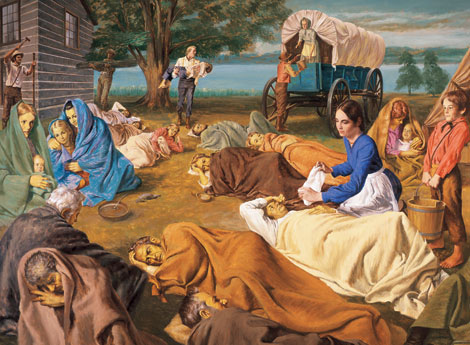
In Nauvoo, Illinois, Emma and Joseph Smith led efforts to help the hungry, homeless, and sick.
Emma, the Elect Lady of the Restoration, 1839, by Theodore S. Gorka. © 1996 IRI.
Early Relief Society sisters served those in need and occasionally received service themselves. For example, Ellen Douglas joined the Relief Society soon after she and her family arrived in Nauvoo in March 1842. Three months later, her husband, George, died. She and her family worked together to provide for themselves, but they struggled without their husband and father. Still, Ellen participated in the work of the Relief Society by actively relieving others’ suffering, sickness, and poverty. Then in April 1844, she and some of her children fell ill and found themselves in need of help. She wrote a letter to her family in England describing how the Relief Society came to her aid when she went to visit a friend named Ann:
“After I [had] begun to get well I went down into the city on a visit to where Ann lived, and I stayed two nights. … The woman where Ann lived would have me make application to the Female Relief Society for some clothing which I needed for myself and family. I refused to do so, but she said I needed something and that I had been so long sick and if I would not do it myself she would do it for me.” Sister Douglas eventually agreed to ask for help. “We went to one of the sisters,” she continued, “and she asked me what I needed most. I told her that I needed … many things. While I was sick my children [wore] out their clothes because I could not [mend] them, so she said she would do the best she could for me. Ann came over in a few days and they brought the wagon and fetched me such a present as I never received before.”45
“That We May All Sit Down in Heaven Together”
Elder John A. Widtsoe of the Quorum of the Twelve Apostles described the foundational work of the Relief Society: “Relief of poverty, relief of illness; relief of doubt, relief of ignorance—relief of all that hinders the joy and progress of woman. What a magnificent commission!”46
Latter-day Saint women, strong in faith and testimony, have truly been given the “errand of angels.”47 Elder M. Russell Ballard of the Quorum of the Twelve Apostles taught: “Every sister in this Church who has made covenants with the Lord has a divine mandate to help save souls, to lead the women of the world, to strengthen the homes of Zion, and to build the kingdom of God.”48
When Sarah M. Kimball and Margaret Cook decided to begin a sewing society, they wanted to help prepare a temple for the people. Under the inspiration and guidance of a prophet and other priesthood leaders, they and their sisters ultimately helped prepare a people for the temple.
This work continues today. Guided by the principles Joseph Smith taught, Relief Society sisters work together to prepare women and their families for God’s greatest blessings. They joyfully follow the counsel of Joseph Smith’s mother, Lucy Mack Smith: “We must cherish one another, watch over one another, comfort one another and gain instruction, that we may all sit down in heaven together.”49
Toronto Ontario Temple